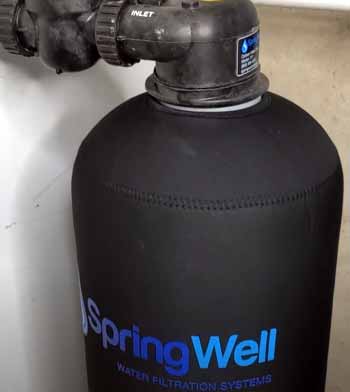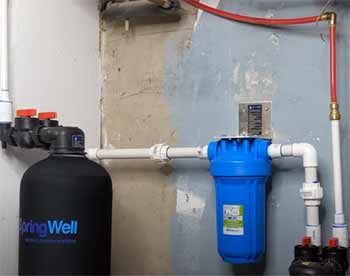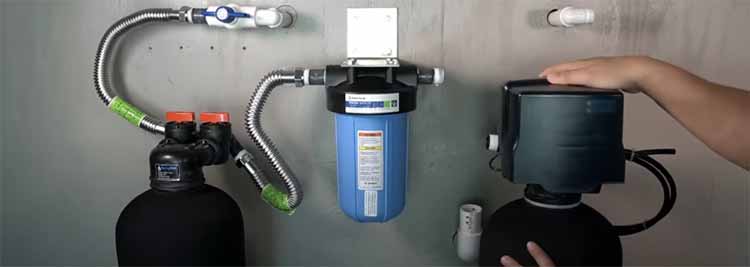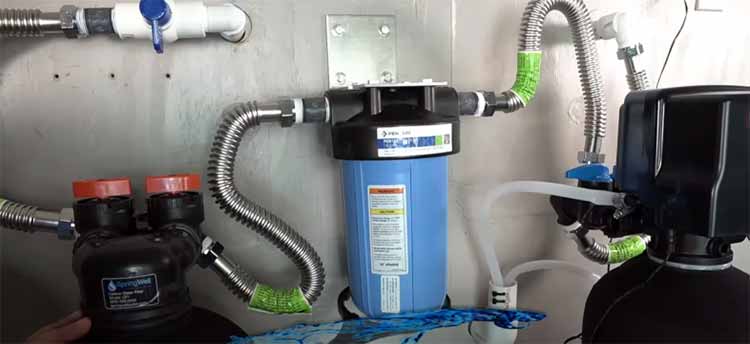Look, if you’re tired of tap water that tastes like a swimming pool or leaves your skin feeling like sandpaper, it’s time to consider a SpringWell water filtration system. I’ve been there—skeptical about whether a whole-house filter is worth the hype.
But after trying it myself, I’m convinced it’s a game-changer for anyone who values clean, tasty water and wants to protect their home from hard water woes. Trust me, you’ll wish you’d made the switch sooner.
In this article, I’ll walk you through my experience, the pros, cons, maintenance tips, and how it stacks up against other brands—so you can decide if it’s right for you.
My Experience With SpringWell Water Filtration

Let me set the scene: I live in a small house with well water that’s been a nightmare for years.
Rusty stains on my sinks, a faint sulfur whiff in the shower, and a taste that made me question every sip—it was rough.
I’d tried cheap pitchers and faucet filters, but they barely scratched the surface.
So, when I heard about SpringWell’s whole-house systems, I figured, “Why not give it a shot?”
I went with the WS1 model, designed for well water, and let me tell you, the difference hit me like a ton of bricks.
Installation was my first hurdle. I’m no plumber, but I’ve got some DIY chops. The instructions were clear, and SpringWell’s online video walked me through it. It took me a solid afternoon—about four hours—cutting pipes and wrestling with fittings in my basement.
If you’re not handy, you might want to call a pro, but I managed with a little sweat and a lot of coffee. The optional easy-install kit they offer for $150? Wish I’d splurged on it—would’ve saved me an hour of cursing.
Once it was up and running, I noticed the change within days. The water tasted crisp, not metallic or eggy like before. My wife stopped complaining about dry skin after showers, and the orange stains on our fixtures? Gone.
I even hooked up the Bluetooth app to the control head—super cool to tweak settings from my phone while lounging on the couch. Sure, it wasn’t cheap—around $2,200 upfront—but seeing my appliances last longer and my water bill not spike from constant fixes? That’s where it started paying off.
The real test came a few months in. We had a family gathering, and with extra showers and dishwashing, the system didn’t flinch.
The 12 gallons-per-minute flow rate kept up like a champ. I’ve been using it for over a year now, and it’s still going strong—no filter swaps, just a quick sediment pre-filter rinse every six months. It’s not perfect (I’ll get to that later), but my experience has been overwhelmingly positive. It’s like I’ve reclaimed my water from the wild.
Pros of SpringWell Water Filtration Systems
SpringWell’s got a lot going for it, and I’m not just saying that because I’m hooked on the results. Here’s what I’ve found—and what you’ll love too.
- Stellar Contaminant Removal

This thing is a beast at cleaning water.
My WS1 tackles up to 7 parts per million (ppm) of iron, 8 ppm of hydrogen sulfide (that rotten egg smell), and 1 ppm of manganese.
I had a water test done before and after, and the numbers don’t lie—those nasty culprits dropped to undetectable levels.
For city water folks, the CF1 model handles chlorine, lead, and even sneaky stuff like PFAS chemicals. You’re getting water that’s not just safe but actually pleasant to drink.
- Low Maintenance, High Reward
I’m lazy about upkeep, so this was a huge win. The main filter media lasts 10 years or a million gallons—basically, set it and forget it. The WS1’s automatic backwash flushes out gunk daily, and the CF1 only needs a sediment pre-filter swap every 6-9 months.
That’s $40 a year, tops. Compared to constantly replacing pitcher filters, it’s a no-brainer. You’ll save time and cash in the long run.
- Impressive Flow Rate
You know that frustration when the shower trickles because some filter’s choking your pressure? Not here. My WS1 pumps out 12 gallons per minute, enough for my three-bathroom house.
The CF1 starts at 9 gpm, but you can upgrade to 20 gpm if you’ve got a bigger place. I’ve never had to wait for water, even with guests hogging the taps. It’s smooth sailing all the way.
- Eco-Friendly Options
If you’re into green living, SpringWell’s got your back. Their salt-free softeners, like the FutureSoft, don’t waste water or dump brine into the environment. My salt-based SS1 does use salt, but the salt-free option was tempting for its zero-waste vibe.
Either way, you’re not stuck with a system that guzzles resources—it’s a thoughtful touch I appreciate.
- Lifetime Warranty and Money-Back Guarantee
This sealed the deal for me. A lifetime warranty on tanks and valves?
That’s confidence in the product. Plus, the six-month money-back guarantee gave me peace of mind when I plunked down the cash. If it didn’t work out, I wasn’t stuck. Spoiler: I didn’t need to return it, but knowing I could was a stress-reliever.
Cons of SpringWell Water Filtration Systems

No product’s perfect, and SpringWell’s got its quirks. Here’s what I’ve run into—and what you should watch out for.
- Pricey Upfront Cost
Let’s not sugarcoat it: this isn’t a budget buy. My WS1 set me back $2,200, and the CF1 starts around $900. Add-ons like UV purifiers or softeners jack it up further. It’s an investment, and if you’re strapped for cash, it might feel like a punch to the wallet.
For me, the long-term payoff made it worth it, but it’s not pocket change.
- Installation Can Be a Hassle
I managed to install mine, but it wasn’t a walk in the park. You need space—about two square feet—near a drain and power source. If your plumbing skills are shaky, you’re looking at hiring someone, which adds to the cost.
That easy-install kit helps, but it’s an extra expense. Be ready to roll up your sleeves or open your checkbook.
- Not a One-Size-Fits-All Solution
SpringWell’s great for specific issues—like my well water woes—but it’s not universal.
The WS1 won’t touch lead or bacteria without upgrades, and the CF1 isn’t built for well water’s unique challenges. You’ve got to match the system to your water test results, or you’re wasting money. It’s tailored, not a cure-all.
- Salt-Based Systems Need TLC
If you go for a salt-based softener like my SS1, brace yourself for some upkeep. I’m adding salt every month—about $10 a bag—and checking the brine tank for clogs. It’s not hard, but it’s more than the salt-free options demand. If you hate chores, this might bug you.
Maintenance Tips For SpringWell Water Filtration Systems

Keeping your SpringWell humming doesn’t take much, but a little know-how goes a long way. Here’s what I’ve learned to keep mine in top shape.
- Check the Sediment Pre-Filter Regularly: For my WS1, the spin-down sediment filter catches big particles before they hit the main system. I rinse it every six months—takes 10 minutes. For the CF1, you’re swapping a 5-micron cartridge every 6-9 months. Mark it on your calendar so you don’t forget. Clean pre-filters mean longer life for the whole setup.
- Monitor Salt Levels (If Applicable): With my SS1 softener, I check the brine tank monthly. If the salt’s low, I toss in a bag—easy, but don’t skip it, or you’ll get hard water creeping back. The app pings me when it’s time, which is handy. Salt-free users? You’re off the hook here—just enjoy the ride.
- Schedule a Backwash (If It’s Not Automatic): My WS1 backwashes itself daily, flushing out trapped junk. If you’ve got a manual setup or notice pressure dropping, trigger a backwash via the control head or app. It’s like hitting refresh on your water quality—keeps things flowing smoothly.
- Test Your Water Annually: Even with a killer system, water chemistry can shift. I do a cheap at-home test yearly to make sure the filter’s still nailing it. If something’s off—like new contaminants—you might need an upgrade. SpringWell’s team can guide you if results get weird.
- Keep the Control Head Happy: The Bluetooth head on my WS1 is slick, but it needs power. I’ve got a battery backup for outages—worth grabbing if you’re in a stormy area. Wipe it down occasionally to avoid dust buildup. It’s your command center, so treat it right.
Comparing SpringWell To Other Brands: How It Stacks Up?
SpringWell’s not the only player in town, so how does it fare against the competition? I’ve poked around, talked to friends, and compared notes—here’s the scoop.
Versus Aquasana, it’s a close call. Aquasana’s Rhino system is solid—handles chlorine and lead like SpringWell’s CF1, and it’s often cheaper upfront, around $700. But its flow rate tops out at 7 gpm, and I’ve heard gripes about pressure drops in bigger homes.
SpringWell’s 9-20 gpm range blows it away for multi-bathroom setups. Maintenance? Aquasana’s cartridge swaps are pricier and more frequent—$100+ every six months. SpringWell wins on longevity and flow.
Then there’s US Water Systems with their Matrixx InFusion. It’s a tank-style beast like SpringWell’s WS1, tackling iron and sulfur with a 15 gpm flow. Priced around $2,500, it’s in the same ballpark, but it uses chemical injection—some folks hate the extra hassle of refilling peroxide.
SpringWell’s air injection feels simpler and greener. I’d pick SpringWell for ease, but Matrixx edges out on iron removal (30 ppm vs. 7 ppm) if your water’s a rusty mess.
Home Master’s 3-Stage system caught my eye for budget shoppers—under $500. It’s cartridge-based, not tank-style, so it’s easier to install. It zaps 99% of contaminants, but the 15 gpm flow comes with a catch: filters need replacing every year or so, costing $100-$150.
SpringWell’s decade-long media life makes it a better long-term bet, though Home Master’s a steal if you’re pinching pennies.
SoftPro’s Iron Master is another well-water contender, boasting 30 ppm iron removal for about $1,800. It’s a single-tank setup like SpringWell, but no Bluetooth fanciness—more old-school.
Friends say it’s reliable, but the 10 gpm flow lags behind SpringWell’s 12-20 gpm. I lean toward SpringWell for tech and versatility, but SoftPro’s a strong pick for heavy iron.
SpringWell stands out for its balance of power, low upkeep, and smart features. It’s not the cheapest, but you get what you pay for—especially if you value hassle-free water for years.
Frequently Asked Questions (FAQ)
From my experience and SpringWell’s specs, the main filtration media lasts about 10 years or 1 million gallons—whichever comes first. My WS1’s been chugging along for over a year with no signs of slowing. The sediment pre-filter needs swapping every 6-9 months, but that’s a small price for a decade of clean water. Test your usage and water quality to pin it down for your place.
I haven’t used iSpring myself, but I’ve chatted with folks who have. Their whole-house systems, like the WGB32B, are solid for city water—removing chlorine and sediment for around $500. Flow’s decent at 15 gpm, but it’s cartridge-based, so you’re replacing filters yearly, costing $100-$150. It’s cheaper than SpringWell upfront, but lacks the longevity and smart tech. Good? Sure. Great? Not quite SpringWell’s league.
SpringWell’s a private company, founded by folks passionate about water quality. I couldn’t dig up exact names—they keep it low-key—but they’re based in the U.S., manufacturing in Colorado. Started in 2018, they’ve built a rep fast. You’re buying from a team that’s all about clean water, not some faceless corp.
Here’s the rub: SpringWell uses “certified components” per NSF/ANSI standards 42 and 53, but the full systems aren’t NSF-certified as a whole. I checked NSF databases—no dice. That bugged me at first, but the performance and user buzz (plus my own results) eased my mind. It’s not a dealbreaker, but if certification’s your hill to die on, look elsewhere.
Conclusion: SpringWell’s Worth The Splash
After living with SpringWell for over a year, I’m sold—and you should be too. It’s not just a filter; it’s a lifeline for your home’s water. From banishing funky tastes to saving your pipes, it delivers where it counts.
Yeah, it’s a chunk of change upfront, and installation’s a chore if you’re not handy, but the pros outweigh the cons by a mile. Compare it to the rest, and it’s clear: SpringWell’s a smart buy for clean, worry-free water.
Go for it—you won’t look back.
